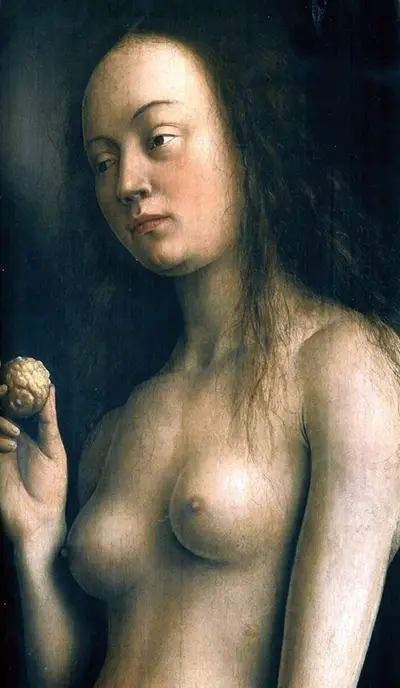Adam and Eve are two narrow portraits by Jan van Eyck for his stunning Ghent Altarpiece
The style of these portraits complement each other and it is likely that they were completed around the same time. You will find several symetrical paintings within Jan van Eyck's diptychs and triptychs which are always placed in opposing positions. Few religious themes can be as closely connected as the Christian story of Adam and Eve, with many other notable artists also covering them at some point within their careers.
Eve sits on the far right of the altarpiece, with the hinges and panel for this painting probably set up by Jan's brother. This symbolic figure has been captured in a variety of art movements across many centuries, such is the impact of Christianity on European society, with the vast majority of depictions being complementary and relatively faithful to the religious scripture.
Nudity is key to the depiction of Adam and Eve within art, representing their naivety and vulnerability. Such portraits show humanity at its simplest, most pure. Religious teachings will use such symbols as a method towards teaching us moral direction through the very same scripture.
Van Eyck was a highly versatile artist and this variety is displayed within the various panels of the Ghent Altarpiece. There are elements of iconography, religious worship, full length portraits and detailed landscapes across the various elements that make up this highly complex piece.
The altarpiece represented a different challenge to Van Eyck that what he had previously achieved. This publically displayed artwork required alterations from his normal formats in order to ensure they would work in this different environment. The wings formed part of the presentation, allowing it to be opened or closed.
The angelic Eve has been depicted by many famous names during the Renaissance and Baroque periods. It was during this period across several centuries that religious representatives would seek out the finest artists and pay them handsomely to depict the key themes around their belief systems. In Europe, where the Renaissance started, Christianity was most dominant and portraits of Adam and Eve were therefore particularly frequent.
Albrecht Durer famously produced an Adam and Eve painting and an engraving. Masaccio also depicted them in his powerful Expulsion from the Garden of Eden fresco. Most famous of all along this theme must, of course, be Michelangelo's Creation of Adam which continues to astound visitors to the Sistine Chapel in their millions every year.




